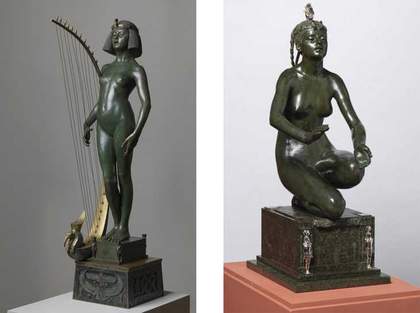
Edward Onslow Ford's The Singer exhibited 1889 and Applause 1893
Photo © Tate
This In Focus discusses the creation and reception of these two sculptures in the context of the Victorian enthusiasm for ancient Egypt, providing the first translations of some of the hieroglyphs found on their decorative bases.

Edward Onslow Ford's The Singer exhibited 1889 and Applause 1893
Photo © Tate
Edward Onslow Ford’s The Singer depicts a nude girl wearing an Egyptian headdress, singing and accompanying herself on a harp. It is not known when the bronze statuette was cast but it was first exhibited at the Royal Academy, London, in 1889. Made a few years later, Ford’s Applause 1893 shows a young Egyptian woman clapping, as though in response to music or dance.
This In Focus project considers how these two sculptures function as a pair and explores the context of their making and reception in late Victorian Britain. It examines the sensitivities surrounding the representation of the female adolescent body at a time when the age of consent had only recently been raised to sixteen.
Published in April 2013, the project is authored by Professor Jason Edwards (University of York) and has contributions from Neal Spencer (Keeper, British Museum) and Tate conservator Pip Laurenson.
ISBN 978-1-84976-388-2